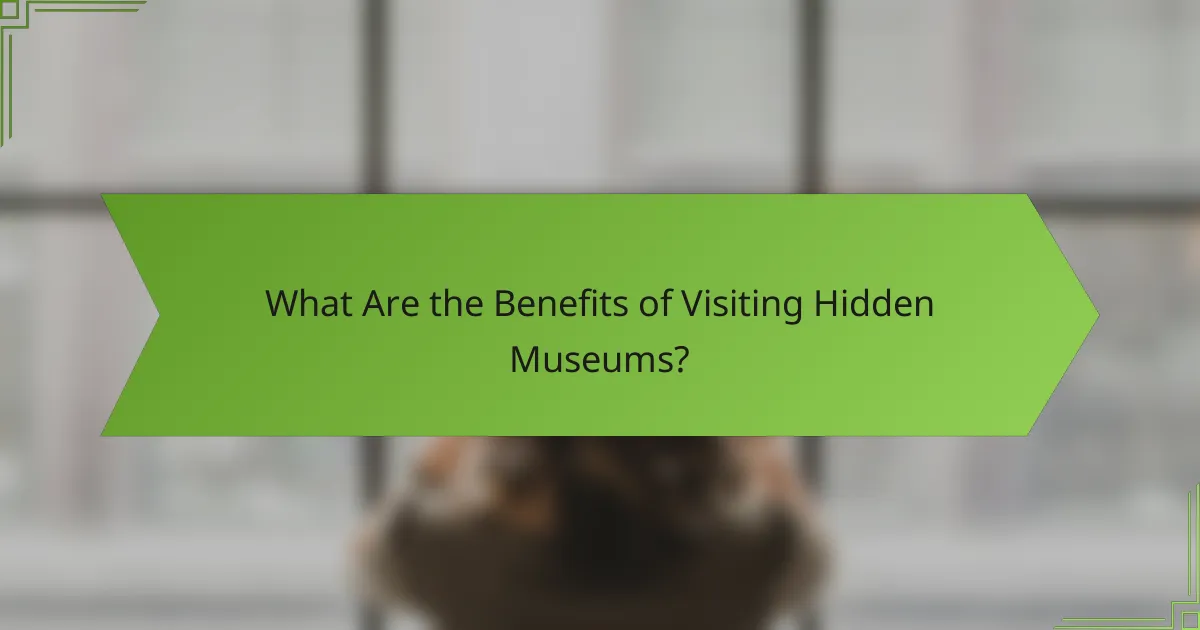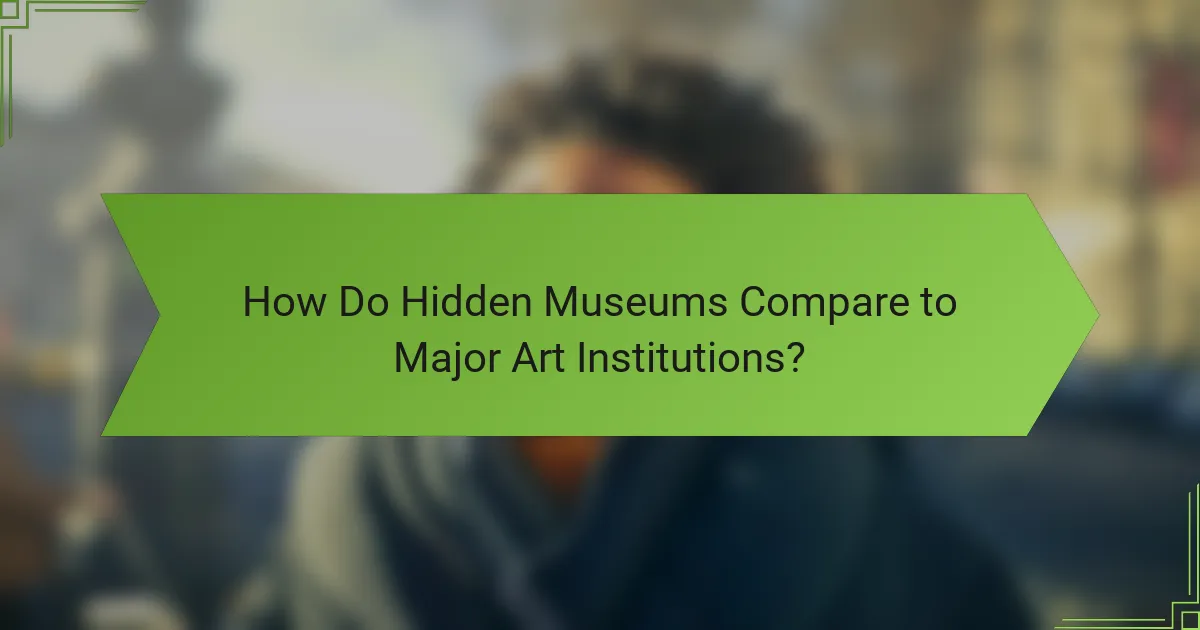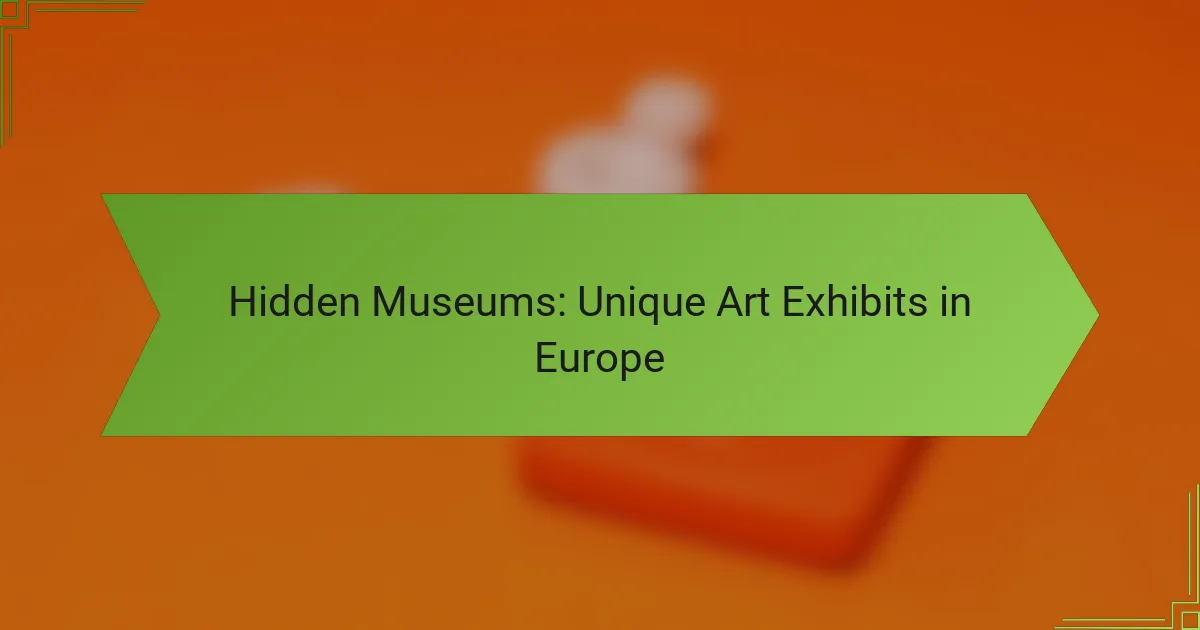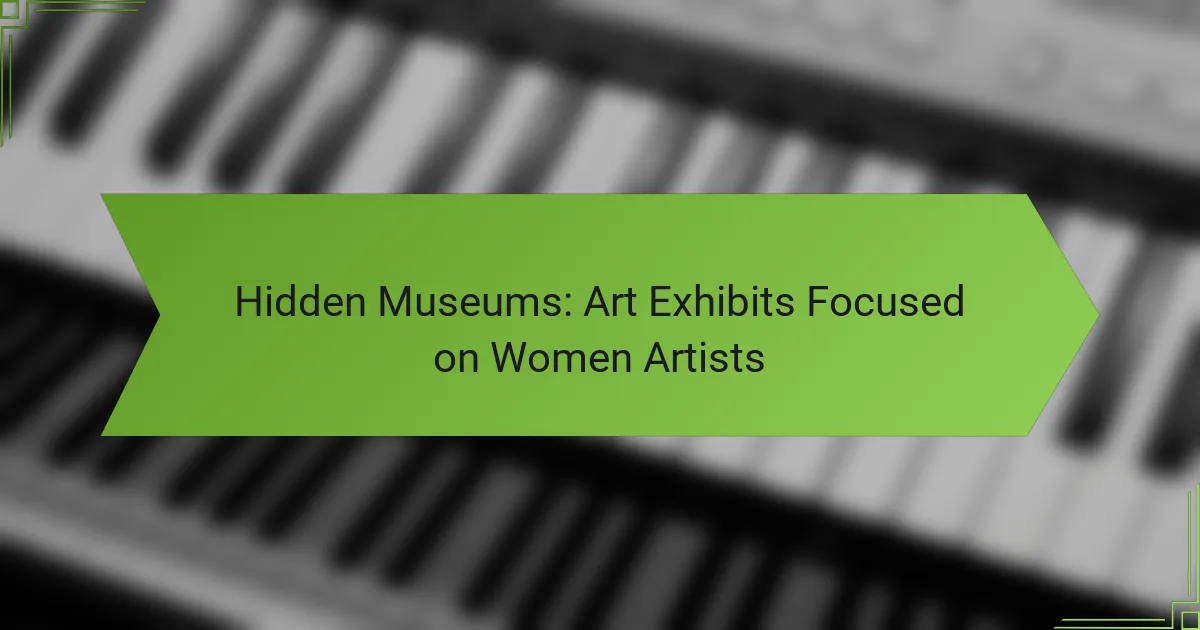Hidden museums in Europe offer a treasure trove of unique art exhibits that often escape the notice of mainstream tourists. These lesser-known venues provide an intimate glimpse into unconventional themes and interactive experiences, allowing visitors to engage with art and history in unexpected ways. With a bit of planning and research, you can uncover these gems and enjoy a fresh perspective on European culture.

What Are the Hidden Museums in Europe?
Hidden museums in Europe are lesser-known art exhibits that showcase unique collections, often away from the mainstream tourist paths. These venues provide a more intimate experience with art and history, allowing visitors to discover treasures that are not widely publicized.
Musée de la Vie Romantique, Paris
Located in the 9th arrondissement, the Musée de la Vie Romantique is dedicated to the Romantic era, featuring works from artists like George Sand and Eugène Delacroix. The museum is housed in a charming 19th-century mansion, surrounded by a lovely garden that adds to its serene atmosphere.
Visitors can explore a collection of paintings, sculptures, and personal artifacts that reflect the lives and passions of the Romantic artists. The museum often hosts temporary exhibitions and literary events, making it a vibrant cultural spot in Paris.
Museo del Prado’s Secret Rooms, Madrid
The Museo del Prado, one of the most famous art museums in the world, has hidden rooms that offer a glimpse into lesser-known works and private collections. These secret spaces often feature rotating exhibits that highlight specific themes or artists, providing a fresh perspective on the museum’s vast holdings.
To access these hidden areas, visitors may need to join guided tours or check the museum’s schedule for special events. This experience allows art lovers to engage with pieces that are not part of the main exhibition, enriching their understanding of Spanish art history.
Palazzo Venier dei Leoni, Venice
The Palazzo Venier dei Leoni is home to the Peggy Guggenheim Collection, showcasing modern art in a stunning Venetian palace. While the main collection is well-known, the museum also features lesser-known works and temporary exhibitions that delve into specific artists or movements.
Visitors can enjoy the beautiful gardens and the picturesque views of the Grand Canal, making it a perfect spot for art enthusiasts seeking a quieter experience. Keep an eye out for special events and guided tours that explore the hidden gems of the collection.
Friedrichshain Museum, Berlin
The Friedrichshain Museum offers a unique look at the history and culture of Berlin’s Friedrichshain district. This small museum features local art, historical artifacts, and exhibitions that reflect the area’s vibrant community life.
With a focus on grassroots movements and local artists, the museum provides an authentic experience of Berlin’s cultural landscape. Visitors should check for workshops and community events that often take place, enhancing the interactive nature of the museum.

What Unique Art Exhibits Can You Find?
Unique art exhibits in Europe often showcase unconventional themes and interactive experiences that engage visitors in unexpected ways. From emotional installations to mind-bending illusions, these hidden museums offer a fresh perspective on art and culture.
Temporary Installations at the Museum of Broken Relationships, Zagreb
The Museum of Broken Relationships features temporary installations that explore the theme of love and loss through personal objects and stories. Each exhibit is curated from contributions by individuals who share their experiences, making the displays deeply personal and relatable.
Visitors can expect to see a variety of items, from letters and photographs to everyday objects, each accompanied by a narrative that explains its significance. This museum emphasizes the universality of heartbreak, inviting reflection and empathy.
Interactive Art at the Museum of Illusions, Amsterdam
The Museum of Illusions in Amsterdam offers interactive art experiences that challenge perceptions and engage the senses. Visitors can explore optical illusions, holograms, and immersive installations that create a playful atmosphere.
Key attractions include the Infinity Room and the Ames Room, where visitors can take photos that create stunning visual effects. This museum encourages participation, making it ideal for families and groups looking for a fun and memorable outing.
Hidden Treasures at the Museum of the History of Science, Oxford
The Museum of the History of Science in Oxford houses a collection of scientific instruments and artifacts that reveal the evolution of science and technology. Among its hidden treasures are rare items such as astrolabes, early microscopes, and original manuscripts from notable scientists.
This museum provides insight into the history of scientific discovery, showcasing how these tools shaped our understanding of the world. Visitors can engage with exhibits that highlight the intersection of art and science, offering a unique perspective on innovation.

How to Access These Hidden Museums?
Accessing hidden museums in Europe often requires some planning, as many of these unique art exhibits do not have the same visibility as larger institutions. Researching online for ticket availability and local transport options can enhance your experience and ensure you don’t miss out on these treasures.
Online Booking Options
Many hidden museums offer online booking to streamline entry and avoid long queues. Websites often provide ticket purchasing options, which can range from immediate access to timed entry slots. It’s advisable to book tickets in advance, especially during peak tourist seasons, to secure your visit.
Some museums may also offer discounts for students, seniors, or groups, so check their official websites for any promotional offers. Additionally, consider subscribing to newsletters for updates on special exhibits or events that may require advance reservations.
Guided Tours Availability
Guided tours are frequently available at hidden museums, providing deeper insights into the exhibits and the history behind them. These tours can be led by knowledgeable local guides who enhance the experience with stories and context that enrich your understanding of the art.
Check the museum’s website for scheduled tours, which may vary by day or season. Some museums may offer private tours for a more personalized experience, while others might have audio guides available for self-exploration.
Local Transport Recommendations
Reaching hidden museums often involves navigating local transport systems, which can vary significantly across Europe. Research public transport options such as buses, trams, or metro lines that connect to the museum’s location. Many cities also provide bike-sharing programs, which can be a scenic way to travel.
Consider purchasing a local transport pass if you plan to visit multiple sites, as it can save you money and simplify your travel. Always check the latest schedules and routes, as they can change frequently, especially on weekends or holidays.

What Are the Benefits of Visiting Hidden Museums?
Visiting hidden museums offers unique benefits that enhance the art-viewing experience. These smaller, lesser-known venues often provide a more intimate and engaging atmosphere, allowing visitors to connect deeply with the art and culture on display.
Unique Cultural Experiences
Hidden museums often showcase local art and history that larger institutions may overlook. This can include regional artists, traditional crafts, or niche themes that reflect the community’s identity. For example, a small museum in a quaint European town might focus on local folklore or historical events significant to that area.
Engaging with these unique cultural experiences allows visitors to gain insights into the local way of life, traditions, and artistic expressions that are not typically found in mainstream galleries. This personal connection can make the visit more memorable and enriching.
Less Crowded Environments
One of the main advantages of hidden museums is the reduced number of visitors. Unlike major art institutions that can become overcrowded, these smaller venues often provide a peaceful setting for exploration. This tranquility allows for a more focused appreciation of the artworks without the distractions of large crowds.
With fewer people around, visitors can take their time, engage in conversations with staff, and even enjoy a more personalized experience. This is particularly beneficial for those who prefer a reflective and immersive art experience.
Access to Exclusive Artworks
Hidden museums frequently feature exclusive collections or temporary exhibits that are not available elsewhere. This can include works by emerging artists or pieces from private collections that are rarely shown to the public. For instance, a small museum might host a rotating exhibit of local artists, providing a platform for new talent.
By visiting these venues, art enthusiasts can discover unique pieces and gain insights into the creative process behind them. This access to exclusive artworks can enhance one’s appreciation for the diversity and richness of the art world.

How Do Hidden Museums Compare to Major Art Institutions?
Hidden museums often provide a stark contrast to major art institutions, focusing on unique, niche collections rather than broad, mainstream exhibits. They typically offer a more personal experience, allowing visitors to engage deeply with the art in a less commercialized environment.
Intimate Settings vs. Large Crowds
Hidden museums are usually located in smaller, less trafficked venues, fostering an intimate atmosphere that allows for personal connections with the art. This contrasts sharply with major institutions, which can attract thousands of visitors daily, often leading to crowded spaces and a hurried experience.
For example, a hidden museum might have only a few dozen visitors at a time, enabling guests to explore exhibits at their own pace. In contrast, larger galleries may require timed tickets or reservations to manage the influx of visitors.
Specialized Collections vs. General Exhibits
Hidden museums often focus on specialized collections that highlight specific themes, artists, or historical periods, making them unique destinations for enthusiasts. Major art institutions, on the other hand, tend to offer a broader range of general exhibits that cater to diverse audiences.
For instance, a hidden museum might showcase contemporary street art or local artisans, while a large museum may feature a wide array of classical and modern works from around the world. This specialization allows hidden museums to attract niche audiences who seek out specific artistic expressions.



